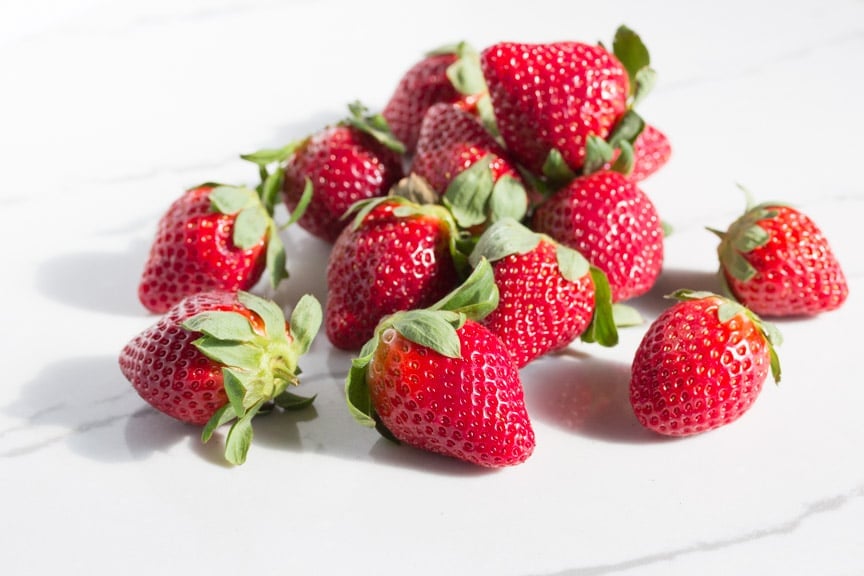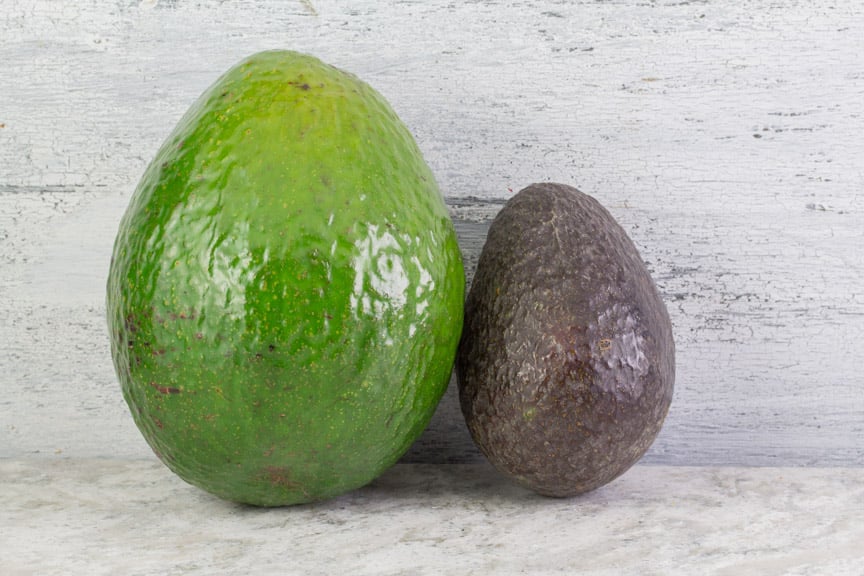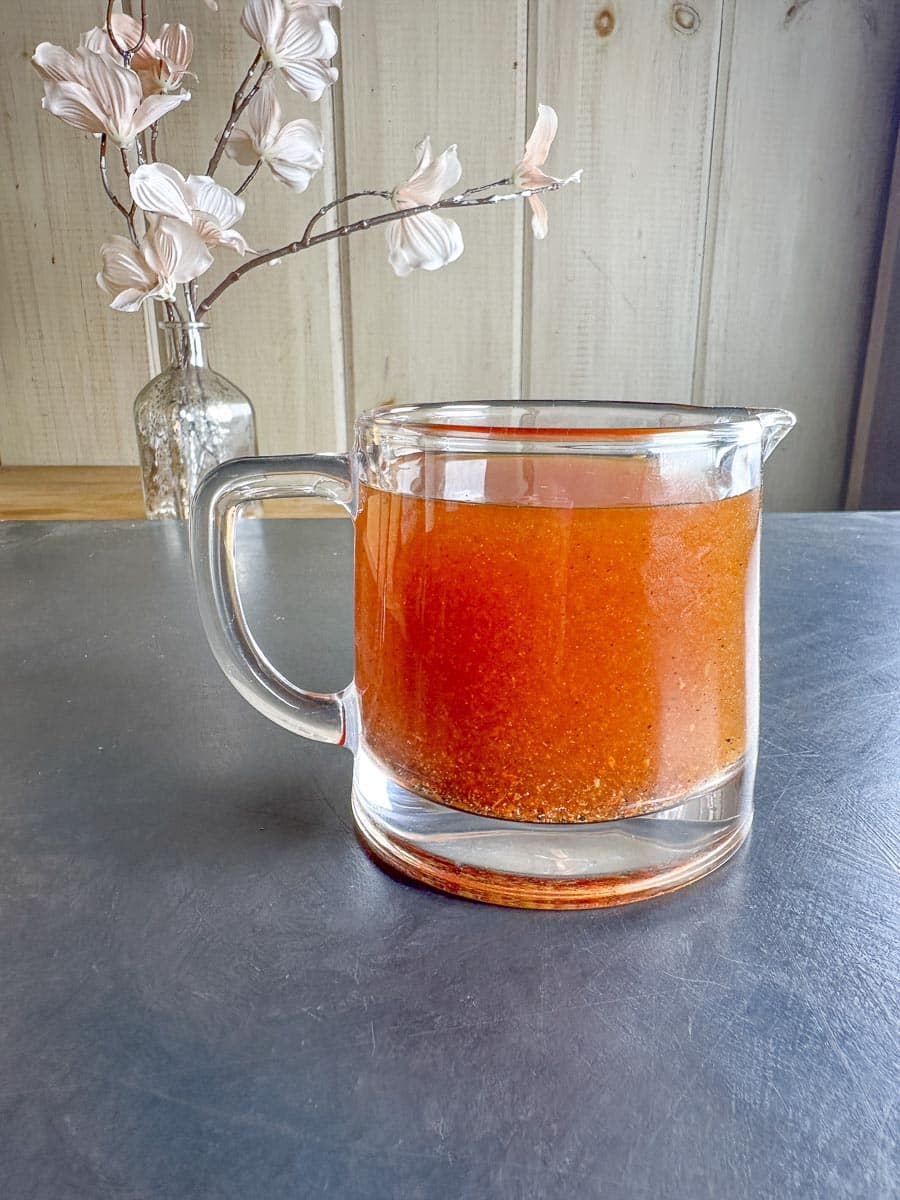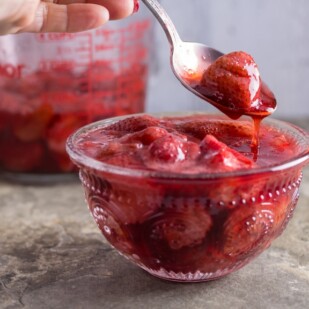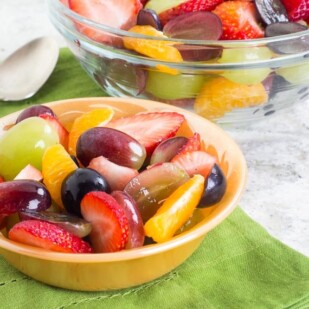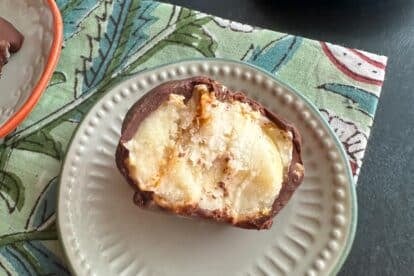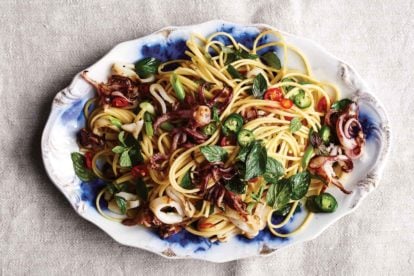Our Low FODMAP Strawberry Feta Pasta Salad with Avocado was created when I decided to have a strawberry party during peak strawberry season. The idea was that everybody coming would bring a dish highlighting this versatile berry, but of course I was going to provide several recipes as well. This pasta salad was very well received. Low FODMAP gluten-free pasta is combined with juicy, sweet strawberries, salty feta, lush avocado and a creamy Greek yogurt dressing.
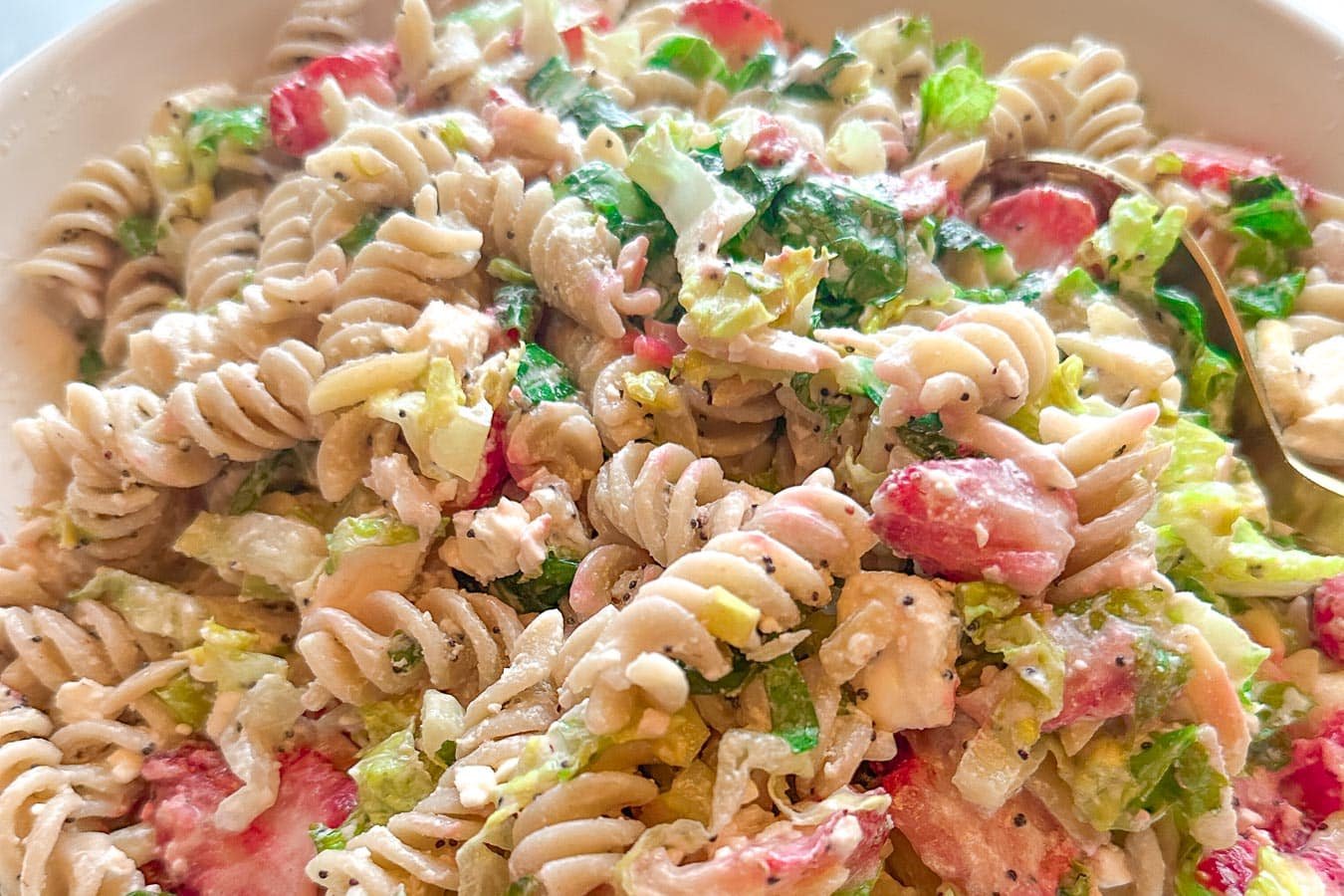
The shredded lettuce might seem odd, but it adds moisture, texture and bulk to the dish. This salad is hearty enough for a main dish, but also works wonderfully as a side dish to all kinds of grilled proteins, especially chicken and pork.
Please read through the recipe before starting because there are some important notes about the process. They mostly have to do with cooking the pasta as close to serving time as possible.

I apologize for not having any images of the process, but I was deep in preparing for the party, as you can see above. Really, this recipe is so easy: you whisk together a salad dressing, boil water and cook pasta, and then toss everything together in a bowl. Easy enough even for novice cooks.
Pasta In Pasta Salad
Of course there is going to be pasta in pasta salad, and you probably don’t think there is much more to think about. On the contrary. I have a lot to say about pasta in pasta salad. I absolutely abhor any pasta salad that has been refrigerated. The pasta texture becomes quite firm and, to my palate, verging on inedible.
My suggestion to you is to prep everything that you need for this dish and then cook the pasta within an hour or two of when you will be serving the dish for optimum results.
Of course, not everyone is as picky as I am, and I know people who have made this recipe, refrigerated the salad, brought it to room temperature and have served it to raves. I just want to make sure you know how to get the most out of this recipe.
I highly recommend Jovial rice pasta for this recipe, for its texture and flavor.
Do Ahead Tips
Other than cooking the pasta, you can do most of the prep ahead.
- Toast the almonds and store at room temperature for up to a month.
- Make the dressing and refrigerate for up to a week.
- Crumble the feta and refrigerate in airtight container for up to a week.
- Shred the lettuce and refrigerate overnight (I put in a zip top bag).
- Hull and slice the strawberries a day ahead; refrigerate.
Let’s Talk About Feta
Feta cheese is a wonderfully salty, texture-laden cheese choice – but not all feta is created equal, not by a longshot.
First of all, feta can be made with sheep milk, goat’s milk, cow’s milk, and even combinations. Then, when it comes to texture, it can be so soft that you cannot even crumble it, but it could be spread. There are versions that are extremely firm and would hold a cubed shape, and then there are feta that are somewhere in-between and have a firmness, but will allow you to crumble them. That is the best texture for this dish. It allows a little creaminess to be added to the dish overall, but still retain some shape and texture. I love sheep’s milk versions, if you can source some.
Feta does have a very generous low FODMAP serving size. According to Monash lab testing a serving is 40 g, and remains low FODMAP up to 500 g, which is the largest amount that they have lab tested.
Frequently Asked Questions
This popular berry has been lab tested by both Monash University and FODMAP Friendly. Monash lab testing initially reported that no FODMAPs were detected in strawberries. They suggested 10 medium berries (150 g) as a serving. Subsequent lab tests in 2021 state 5 strawberries or 65 g as low FODMAP and the “no FODMAP” language has been removed; they show fructose content. What this tells us is that strawberries can contain no FODMAPs, or they can. There is no way to tell what the FODMAP content is of the berries you buy.
FODMAP Friendly initially gave strawberries a “pass” and pegged 10 medium berries at (140 g) as a serving. They retested in 2021 and now state that their lab results show that a low FODMAP serving size is 50 g (or 4 berries). We suggest that you test your own tolerance (as always) and eat to your personal limit. Remember, the varieties, ripeness etc. of the berries that were lab tested will be different from those that you eat. Use the lab tests as a guide.
Both Monash University and FODMAP Friendly have lab tested avocados, and their results vary from one another. In addition, they have also re-tested avocados and lab test results vary from before; this was to be expected. ALWAYS note that lab tests are meant to be guides only and represent snapshots in time of the avocados that are tested during that particular testing round.
Monash University lab testing had reported that avocado was low FODMAP at 30 g, or what they called “an eighth of an avocado”; this volume amount means nothing, BTW. Avocados can vary from 3-ounces (85 g) a piece to over 5-pounds (2.3 kg). GO BY WEIGHT – and the weight is for flesh only. Current lab tests have a low FODMAP serving size set at 60 g.
Their details state that the avocados they tested contain sorbitol. FODMAP Friendly lab testing initially reported that avocados had a low FODMAP “Pass” at 120 g (4.23-ounces). The details stated that avocados tested contained mannitol, fructans and some excess fructose. FODMAP Friendly recently re-tested both ripe Hass avocado and unripe Hass avocado. The lab testing reports that both ripe and unripe get a “Pass” at 80g (2.82 ounces). Their details state that both the ripe and unripe avocados were low in all FODMAP groups, and in fact both ripe and unripe have a max low FODMAP serving size, as determined in the lab, to be 1000 g (that is not a typo). PLEASE read our article, Is Avocado Low FODMAP?
Honey is typically thought of as a high FODMAP food, because the serving size is so low. However, there is a small low FODMAP serving size, which is used to great advantage in this recipe.
Check out our article High FODMAP Foods With Low FODMAP Serving Sizes. and our article Is Honey Low FODMAP?
Monash University has lab tested clover honey as well as a more nonspecific honey, the latter of which has twice the serving size of the former. 1 teaspoon, or 7 g, of honey is considered low FODMAP (½ teaspoon (3 g) for clover honey is low FODMAP).
There is some very interesting science about the different ratios of glucose to fructose in various types of honey. When a food has more glucose than fructose – such as in white granulated sugar – it is low FODMAP. When fructose is in excess of glucose, the food flips to high FODMAP. Learn more by reading about monosaccharides.
Since I became obsessed with everything strawberry, I purchased some strawberry vinegar and used it in this recipe. Of course, this is a specialty item and I do not expect any of you to just have it on hand. If you are a vinegar lover like me, you might want to get some. I promise you that you will find many uses for it, including this awesome vinegar based barbecue sauce that we came up with.
The apple cider vinegar works quite well in this recipe, as does rice vinegar.
FODMAP Information
All recipes are based upon Monash University & FODMAP Friendly science at time of initial publication.
- Almonds: Both Monash University and FODMAP Friendly have lab tested whole almonds, and their results vary from one another. Monash says that a Green Light low FODMAP portion is 10 whole almonds at 12 g, but a high FODMAP portion is 20 whole almonds at 24 g. FODMAP Friendly gives them a “Pass” at 30 g or ¼ cup.
- Avocados: Both Monash University and FODMAP Friendly have lab tested avocados, and their results vary from one another. In addition, they have also re-tested avocados and lab test results vary from before; this was to be expected. ALWAYS note that lab tests are meant to be guides only and represent snapshots in time of the avocados that are tested during that particular testing round. Monash University lab testing had reported that avocado was low FODMAP at 30 g, or what they called “an eighth of an avocado”; this volume amount means nothing, BTW. Avocados can vary from 3-ounces (85 g) a piece to over 5-pounds (2.3 kg). GO BY WEIGHT – and the weight is for flesh only. Current lab tests have a low FODMAP serving size set at 60 g. Their details state that the avocados they tested contain sorbitol. FODMAP Friendly lab testing initially reported that avocados had a low FODMAP “Pass” at 120 g (4.23-ounces). The details stated that avocados tested contained mannitol, fructans and some excess fructose. FODMAP Friendly recently re-tested both ripe Hass avocado and unripe Hass avocado. The lab testing reports that both ripe and unripe get a “Pass” at 80g (2.82 ounces). Their details state that both the ripe and unripe avocados were low in all FODMAP groups, and in fact both ripe and unripe have a max low FODMAP serving size, as determined in the lab, to be 1000 g (that is not a typo). PLEASE read our article, Is Avocado Low FODMAP?
- Cheese: Many cheeses have low FODMAP serving sizes. The low FODMAP diet is not a dairy-free diet. Hard cheeses such as Parmigiano Reggiano or Pecorino Romano have been lab tested by Monash University and are low FODMAP in 40 g amounts – and the servings remain low FODMAP up to 500 g.
- Honey: Honey has been lab tested by both FODMAP Friendly and Monash University. FODMAP Friendly gives it a “Fail” at 2 teaspoons (15 g). Monash says that while clover honey specifically is only low FODMAP at ½ teaspoon (3 g), they state that honey is low FODMAP in 1 teaspoon (7 g) amounts.
- Lettuce: Romaine lettuce has been lab tested by both Monash and FODMAP Friendly. Also labeled as cos lettuce on the Monash app, their lab tested determined a generous low FODMAP serving size of 2 cups (75 g). FODMAP Friendly gives it a “Pass” at 1 cup (75 g).
- Oil: All pure oils are fats and contain no carbohydrates, therefore they contain no FODMAPs.
- Pasta: Please note that small amounts (74 g) of conventional wheat-based pasta is low FODMAP Use your Monash app for more information; the diet is not wheat or gluten-free. If you are gluten-free, you have to read labels, as there are many low FODMAP gluten-free brands of pasta available, but remember that gluten-free does not equal low FODMAP. Use what is called for in individual recipes. Our go-to is rice-based pasta. Monash University and FODMAP Friendly have both tested “gluten-free” pasta, but they do not specify what the pasta was made from. Monash says gluten-free pasta is low FODMAP at 145 g or 1 cup cooked; FODMAP Friendly lab testing suggested 2 cups or 146 g cooked is low FODMAP. Monash has also lab tested pasta made from rice, which they list under “rice stick” and it is low FODMAP at 220 g, which no Moderate or High FODMAP amounts given.
- Scallions: Monash University lab testing found no FODMAPs detected in scallion greens; they suggest a 75 g serving size. FODMAP Friendly has also lab tested scallions: their recommended serving size for the green parts is 16 g, with a max low FODMAP serving of 161 g. They have also tested the bulb and it is low FODMAP in 19 g portions, which is about 2 tablespoons finely chopped.
- Strawberries: This popular berry has been lab tested by both Monash University and FODMAP Friendly. Monash lab testing initially reported that no FODMAPs were detected in strawberries. They suggested 10 medium berries (150 g) as a serving. Subsequent lab tests in 2021 state 5 strawberries or 65 g as low FODMAP and the “no FODMAP” language has been removed; they show fructose content. What this tells us is that strawberries can contain no FODMAPs, or they can. There is no way to tell what the FODMAP content is of the berries you buy. FODMAP Friendly initially gave strawberries a “pass” and pegged 10 medium berries at (140 g) as a serving. They retested in 2021 and now state that their lab results show that a low FODMAP serving size is 50 g (or 4 berries). We suggest that you test your own tolerance (as always) and eat to your personal limit. Remember, the varieties, ripeness etc. of the berries that were lab tested will be different from those that you eat. Use the lab tests as a guide.
- Vinegar: Several vinegars have been lab tested by both Monash and FODMAP Friendly. From Monash: Apple cider vinegar is low FODMAP at 2 Australian tablespoons or 42 g; Balsamic vinegar is low FODMAP at 1 Australian tablespoons or 21 g; Malt vinegar contains no FODMAPs; Rice wine vinegar is low FODMAP at 2 Australian tablespoons or 42 g. From FODMAP Friendly: Balsamic gets a “Pass” at 2.5 tablespoons or 42 ml. Apple cider vinegar gets a “Pass” at 1 tablespoon or 14 g (don’t ask me why one is in milliliters and the other in grams).
Please always refer to the Monash University & FODMAP Friendly smartphone apps for the most up-to-date lab tested information. Foods will be retested from time to time; in the case of raw ingredients, such as fruits and vegetables, results may vary. All lab tested results are valid and represent a snapshot in time. As always, your tolerance is what counts; please eat accordingly. The ultimate goal of the low FODMAP diet is to eat as broadly as possible, without triggering symptoms, for the healthiest microbiome.
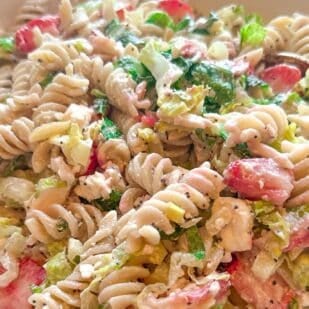
Low FODMAP Strawberry Feta Pasta Salad with Avocado
Our Low FODMAP Strawberry Feta Pasta Salad with Avocado was created when I decided to have a strawberry party during peak strawberry season. The idea was that everybody coming would bring a dish highlighting this versatile berry, but of course I was going to provide several recipes as well. This pasta salad was very well received, and is hearty enough for a main dish, but also works wonderfully as a side dish to all kinds of grilled proteins, especially chicken and pork.
Ingredients:
Dressing:
- 2/3 cup (142g) plain Greek yogurt
- 1/4 cup (60 ml) apple cider vinegar, or strawberry vinegar, if you have it
- 1/4 cup (60 ml) extra-virgin olive oil
- 1/4 cup (60 ml) honey
- 2 teaspoons poppy seeds
- 1 teaspoon Dijon mustard
- Kosher salt
- Freshly ground black pepper
Pasta Salad:
- 1- pound (455 g) low FODMAP, gluten-free pasta, such as Jovial fusilli
- 1- pound (455 g) fresh strawberries, hulled and sliced
- 4 cups (188 g) shredded Romaine lettuce
- 1 cup (300 g) fresh peeled, pitted, diced avocados
- 3/4 cup (113 g) crumbled feta cheese
- ½ cup (46 g) lightly toasted sliced almonds, optional
- ¼ cup (16 g) chopped scallions, green parts only
Preparation:
-
Make the Dressing: In a small bowl, whisk together the yogurt, vinegar, oil, honey, poppy seeds, and Dijon mustard. Alternatively, you can shake everything together in a lidded jar. Season to taste with salt and pepper; set aside.
-
Cook the Pasta: Cook the pasta till al dente in a large pot of salted water, drain, and run cool water over the pasta to halt cooking. Shake the colander to remove as much water as possible and then pour pasta into a large mixing bowl. Allow the pasta to cool to room temperature.
-
Assemble the Salad: On top of the pasta, add the strawberries, lettuce, avocado, feta, optional almonds, and scallions. Drizzle dressing on top and fold everything together gently but thoroughly. Serve immediately or cover and hold up to 2 hours at room temperature. (See do-ahead tips in body of post above). You can refrigerate the salad in an airtight container for up to 3 days, but please at least bring back to room temperature before serving, which could take hours.
Notes:
FODMAP Information
All recipes are based upon Monash University & FODMAP Friendly science at time of initial publication.
• Almonds: Both Monash University and FODMAP Friendly have lab tested whole almonds, and their results vary from one another. Monash says that a Green Light low FODMAP portion is 10 whole almonds at 12 g, but a high FODMAP portion is 20 whole almonds at 24 g. FODMAP Friendly gives them a “Pass” at 30 g or ¼ cup.
• Avocados: Both Monash University and FODMAP Friendly have lab tested avocados, and their results vary from one another. In addition, they have also re-tested avocados and lab test results vary from before; this was to be expected. ALWAYS note that lab tests are meant to be guides only and represent snapshots in time of the avocados that are tested during that particular testing round. Monash University lab testing had reported that avocado was low FODMAP at 30 g, or what they called “an eighth of an avocado”; this volume amount means nothing, BTW. Avocados can vary from 3-ounces (85 g) a piece to over 5-pounds (2.3 kg). GO BY WEIGHT – and the weight is for flesh only. Current lab tests have a low FODMAP serving size set at 60 g. Their details state that the avocados they tested contain sorbitol. FODMAP Friendly lab testing initially reported that avocados had a low FODMAP “Pass” at 120 g (4.23-ounces). The details stated that avocados tested contained mannitol, fructans and some excess fructose. FODMAP Friendly recently re-tested both ripe Hass avocado and unripe Hass avocado. The lab testing reports that both ripe and unripe get a “Pass” at 80g (2.82 ounces). Their details state that both the ripe and unripe avocados were low in all FODMAP groups, and in fact both ripe and unripe have a max low FODMAP serving size, as determined in the lab, to be 1000 g (that is not a typo). PLEASE read our article, Is Avocado Low FODMAP?
• Cheese: Many cheeses have low FODMAP serving sizes. The low FODMAP diet is not a dairy-free diet. Hard cheeses such as Parmigiano Reggiano or Pecorino Romano have been lab tested by Monash University and are low FODMAP in 40 g amounts – and the servings remain low FODMAP up to 500 g.
• Honey: Honey has been lab tested by both FODMAP Friendly and Monash University. FODMAP Friendly gives it a “Fail” at 2 teaspoons (15 g). Monash says that while clover honey specifically is only low FODMAP at ½ teaspoon (3 g), they state that honey is low FODMAP in 1 teaspoon (7 g) amounts.
• Lettuce: Romaine lettuce has been lab tested by both Monash and FODMAP Friendly. Also labeled as cos lettuce on the Monash app, their lab tested determined a generous low FODMAP serving size of 2 cups (75 g). FODMAP Friendly gives it a “Pass” at 1 cup (75 g).
• Oil: All pure oils are fats and contain no carbohydrates, therefore they contain no FODMAPs.
• Pasta: Please note that small amounts (74 g) of conventional wheat-based pasta is low FODMAP Use your Monash app for more information; the diet is not wheat or gluten-free. If you are gluten-free, you have to read labels, as there are many low FODMAP gluten-free brands of pasta available, but remember that gluten-free does not equal low FODMAP. Use what is called for in individual recipes. Our go-to is rice-based pasta. Monash University and FODMAP Friendly have both tested “gluten-free” pasta, but they do not specify what the pasta was made from. Monash says gluten-free pasta is low FODMAP at 145 g or 1 cup cooked; FODMAP Friendly lab testing suggested 2 cups or 146 g cooked is low FODMAP. Monash has also lab tested pasta made from rice, which they list under “rice stick” and it is low FODMAP at 220 g, which no Moderate or High FODMAP amounts given.
• Scallions: Monash University lab testing found no FODMAPs detected in scallion greens; they suggest a 75 g serving size. FODMAP Friendly has also lab tested scallions: their recommended serving size for the green parts is 16 g, with a max low FODMAP serving of 161 g. They have also tested the bulb and it is low FODMAP in 19 g portions, which is about 2 tablespoons finely chopped.
• Strawberries: This popular berry has been lab tested by both Monash University and FODMAP Friendly. Monash lab testing initially reported that no FODMAPs were detected in strawberries. They suggested 10 medium berries (150 g) as a serving. Subsequent lab tests in 2021 state 5 strawberries or 65 g as low FODMAP and the “no FODMAP” language has been removed; they show fructose content. What this tells us is that strawberries can contain no FODMAPs, or they can. There is no way to tell what the FODMAP content is of the berries you buy. FODMAP Friendly initially gave strawberries a “pass” and pegged 10 medium berries at (140 g) as a serving. They retested in 2021 and now state that their lab results show that a low FODMAP serving size is 50 g (or 4 berries). We suggest that you test your own tolerance (as always) and eat to your personal limit. Remember, the varieties, ripeness etc. of the berries that were lab tested will be different from those that you eat. Use the lab tests as a guide.
• Vinegar: Several vinegars have been lab tested by both Monash and FODMAP Friendly. From Monash: Apple cider vinegar is low FODMAP at 2 Australian tablespoons or 42 g; Balsamic vinegar is low FODMAP at 1 Australian tablespoons or 21 g; Malt vinegar contains no FODMAPs; Rice wine vinegar is low FODMAP at 2 Australian tablespoons or 42 g. From FODMAP Friendly: Balsamic gets a “Pass” at 2.5 tablespoons or 42 ml. Apple cider vinegar gets a “Pass” at 1 tablespoon or 14 g (don’t ask me why one is in milliliters and the other in grams).
Please always refer to the Monash University & FODMAP Friendly smartphone apps for the most up-to-date lab tested information. Foods will be retested from time to time; in the case of raw ingredients, such as fruits and vegetables, results may vary. All lab tested results are valid and represent a snapshot in time. As always, your tolerance is what counts; please eat accordingly. The ultimate goal of the low FODMAP diet is to eat as broadly as possible, without triggering symptoms, for the healthiest microbiome.
Nutrition
All nutritional information is based on third-party calculations and should be considered estimates. Actual nutritional content will vary with brands used, measuring methods, portion sizes and more. For a more detailed explanation, please read our article Understanding The Nutrition Panel Within Our Recipes.
